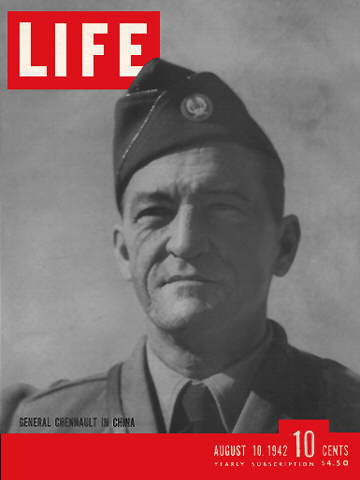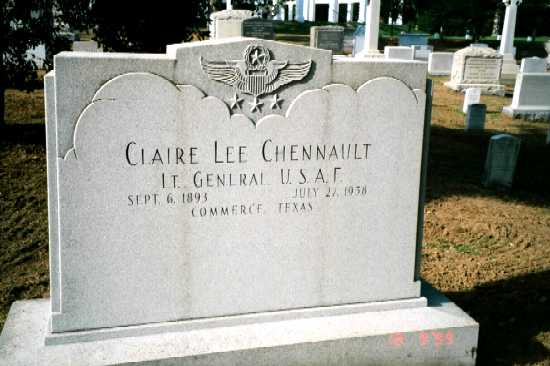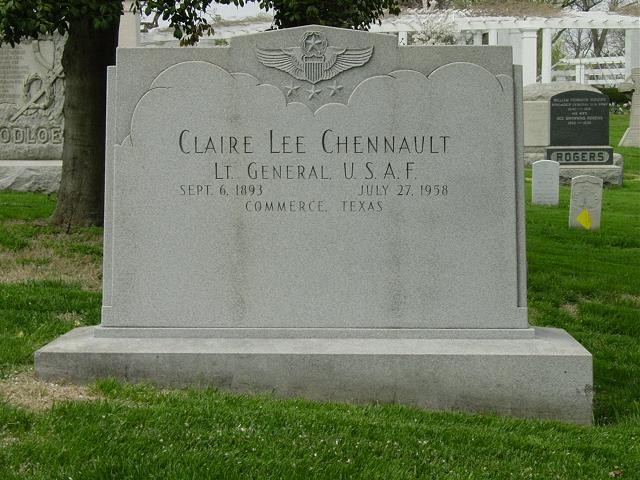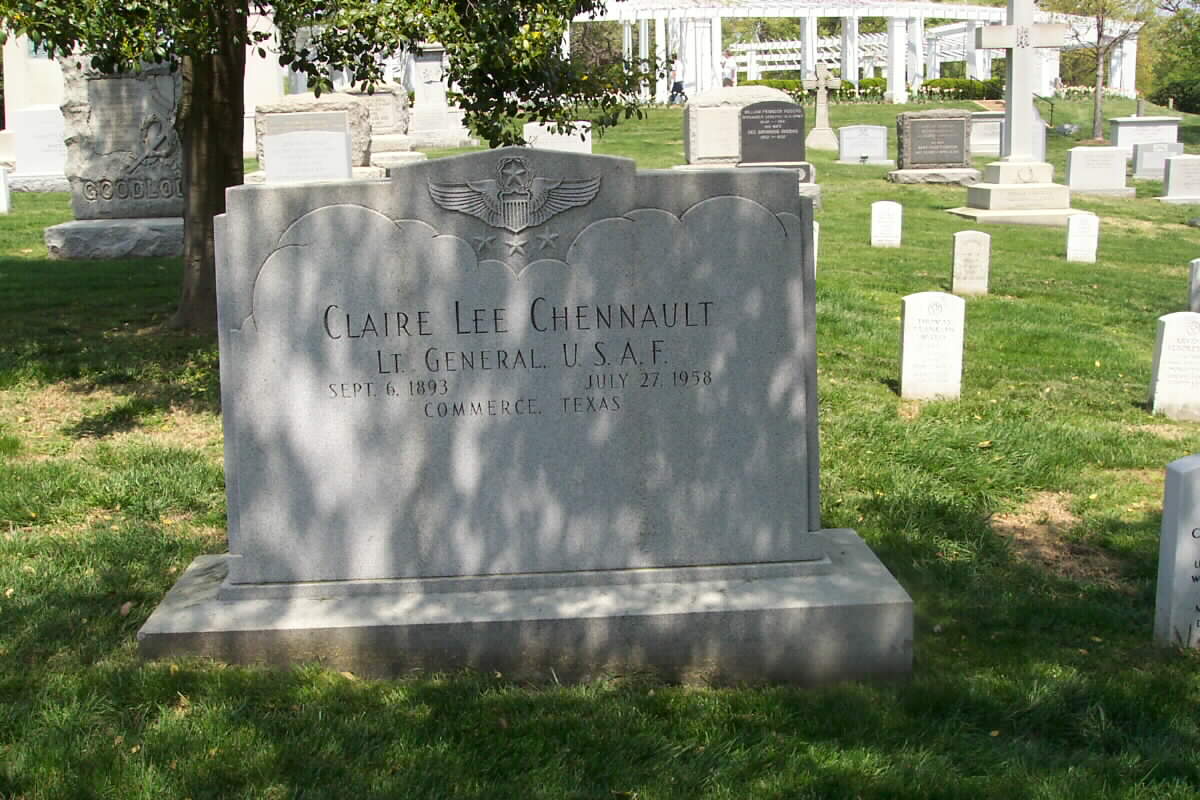
From a 1990 Press Report:
From the cotton fields of Waterproof, Louisiana, came Claire Lee Chennault, a prophetic, controversial military genius who was de-activated twice because of his strident efforts to modernize air power.
Chennault was also a military hero who received at least 17 medals, including the Distinguished Service Medal with Oak Leaf Cluster, and the Distinguished Flying Cross with Oak Leaf Cluster.
Claire Lee Chennault went from being a school teacher in a one-room school in Athens, Louisiana, on to become a general and leader of the famous Flying Tigers.
Ironically, Chennault had ups and downs in his career that matches those of Chennault Air Base in Lake Charles, which was named for him. Both the base and the general were often in political fights, and the base was also cast off by the military, in 1946 and in 1961. And just as the base is still contributing to Calcasieu Parish, Claire Chennault’s innovative changes still contribute to the modern armed forces.
Two of General Chennault’s sons live in Ferriday Robert and Claire “Pat” Another son, Max, lives in Fayetteville, Georgia. Two daughters, Rosemay (Mrs. James Simrell) lives in West Monroe, and Peggy (Mrs. A. Robert Lee) lives in California. Three of Chennault’s sons are deceased John, a retired Colonel in the Air Force; Charles, a retired Master Sergeant in the Air Force; and David, who served in the Navy in World War II.
There are also 36 grandchildren and two great-grandchildren, many of whom live in Louisiana.
Anna Chen Chennault, Chennault’s second wife, and their two daughters, Cynthia and Claire Anna, live in Washington, D.C.
Claire Lee Chennault was 10 years old when the Wright Brothers made their first powered flight in 1903. Raised in the little community of Gilbert, near Waterproof, Claire was the son of John and Jessie Lee Chennault. His mother died when he was young and he became a loner, spending much time by himself in the nearby woods.
In a book he wrote later, “Way of a Fighter,” Chennault said, “My earliest recollections are of roaming the oak woods and moss-draped cypress swamps in northeast Louisiana. Life in these woods and on the bayous and lakes taught me self-confidence and reliance and forced me to make my own decisions.”
Claire Chennault attended LSU for three years, but transferred to Louisiana State Normal for his senior year so he would be eligible for a teaching job. That same year, he attended a high school graduation ceremony in Winnsboro, and there met a young lady named Nell Thompson. They courted for a year, and married on Christmas Eve, 1911.
When World War I began, Chennault enlisted, and for a very short time was stationed at Gerstner Army Camp, south of Lake Charles near Holmwood. Then he went to Kelly Field in San Antonio, Texas.
“The Signal Corps rejected me for flight training three times,” Chennault wrote later. “But taking advantage of the general confusion around Kelly, I found a few genial instructors who were willing to explain the fundamentals of flying from the rear cockpit of a Jenny.
“I was also in charge of fueling and checking the training planes, so whenever there was no cadet handy, I hopped in and racked up another hour of flying time.”
In the spring of 1920, the war ended and Chennault was honorably discharged. But that fall, he put in a request for a commission in the newly organized Air Service and was accepted for their first fighter pilot course.
In 1923, Claire Chennault was sent to Hawaii, where he was commanding officer of the 19th Pursuit Squadron at Luke Field at Pearl Harbor. It was in Hawaii that his sixth and last son, Robert, was born. A few years later, a daughter, Rosemary, was born.
“I think my Hawaiian duty was my happiest time in the Air Corps,” Chennault wrote later. During this time, he initiated many new plans and tactics for military aircraft. He felt that the fighter techniques being taught then were “medieval jousting in dogfights.”
Chennault had a brilliant mind, far ahead of the military strategists of his day. He often sounded like a voice crying in the wilderness as he begged the military hierarchy to modernize training tactics.
“Even yet in 1931,” he wrote, “a World War I ace was still teaching the fighter tactics of 1918, including the dawn patrol and dogfight tactics which were completely inadequate against the new bombers.”
Chennault also tried to introduce the use of parachute troops, but was ridiculed for the suggestion.
He also advocated more firepower for fighting planes. “In 1936, engineers ridiculed my suggestion that four 30-caliber guns could be synchronized to fire through a propeller,” he recalled. “They said it was impossible. But the next year I saw a Russian plane with synchronized guns in action against the Japanese in China.”
But military leaders weren’t listening to Chennault. They didn’t believe fighters could shoot down bombers. One officer even recommended that fighters drop a ball-and-chain device from above in the hope of fouling a bomber’s propellers.
By 1936, Chennault had become executive officer of a pursuit group at Barksdale in Shreveport. But his disagreements with military leaders escalated, and he was asked to take a “health” retirement. He accepted the offer.
It was after his first retirement that the Chennault children remember spending the most time with their father. Robert, who now lives in the Chennault homeplace at Ferriday, recalls: “My father was stern and insisted that we be extra good students, but he also was very good to us and spent a lot of time with us.
“He was very competitive, hating to lose at anything. He took me fishing until I became a better fisherman than he, and then he wouldn’t fish with me anymore.
“He was an avid gardener. He loved his vegetables and didn’t like other people in his garden. He would pick all his produce himself and take it to the kitchen. Then it was up to someone else.
“But he did insist that I keep his asparagus bed weeded, and until this day, I dislike asparagus like President Bush and his broccoli.”
Max Chennault agrees. “He was a good father. He often took us golfing, fishing, hunting and swimming and taught us to play bridge.”
All six sons of Chennault were in service during World War II, and they all came home safely. Daughter Peggy (Mrs. Robert Lee) of California says, “My husband, Bob Lee, was chief of supply for Chennault’s Air Line. We and our two children lived in Shanghai, Canton, Hong Kong, Tianan and Tokyo until the Korean War. It was exciting, sometimes scary, but I wouldn’t trade it for anything.”
Rosemary (Mrs. James Simrell), who now lives in West Monroe, recalls: “We saw quite a bit of Dad after he came back from China and was living in Monroe. He loved his flower garden and had many unusual plants in it, many that he’d brought home from China.”
In the 1930s, the Chennaults moved to San Antonio, Texas, where he was director of flight operations. They lived near a family named Hixson, and a member of that family, Edley Hixson of Lake Charles, remembers the Chennaults well. Edley recalls, “Max and I were friends and went to school together. I knew the family and thought that General Chennault was stern and very military.”
Then came another chapter in Chennault’s career. “At midnight on April 30, 1937,” wrote Chennault later, “with my family settled on the shores of Lake St. John near Waterproof, I officially retired from the U.S. Army with the rank of Captain. On the morning of May 1, I was on my way to San Francisco, China bound.”
Chennault originally planned to remain in China for three months, but he spent the rest of his life there. His new civilian job was to oversee the entire Chinese Air Force, and he was often discouraged because China had such a critical shortage of airplanes and trained pilots.
One day, Chennault saw five landing crackups, and watched several fighter-pilots, supposedly ready for combat, spin-in and kill themselves in basic trainers.
It took Chennault a long time to convince Chinese pilots that their lives were more important than saving face. They simply refused to bail out of a crippled plane because returning without their planes would cause them to lose face.
From the beginning, Chennault liked and respected General and Madame Chiang Kai-shek. Since she was the Secretary General of the Chinese Air Force, she was his boss.
“I have worked with Madam Chiang through long years of bitter defeat,” he wrote later, “and through victories that now seem even more bitter because their promise of peace has not been fulfilled. I believe she is one of the world’s most accomplished, brilliant and determined women.”
After World War II began, Chennault was recalled to military service, then assigned to continue the work he was doing in China.
Chennault recruited volunteers to fight the Japanese in China. The Secretary of the Navy as well as the Secretary of the Army agreed to let their flyers resign from their branch of the service to fly with Chennault, and, without prejudice, to return to their prior jobs when the war was over.
The name “Flying Tigers” came into being about this time. Chennault explained it this way: “Suddenly, we were swamped with newspaper clippings and we were being called the Flying Tigers. But the insignia we made famous was by no means original with us.
“Our pilots copied the shark-tooth design on the P-40s from a colored illustration in the India Illustrated Weekly. Even before that, the German Air Force painted it on some of its Messerschmitts. At any rate, we were somewhat surprised to find ourselves billed under that name.”
True to form, General Claire Chennault was outspoken about several other generals he felt were impeding the war effort in China. His comments sparked a furor, and in 1945, two months before the war ended, he was again retired from the military on another “health” disability.
“We were flying home when news of the Japanese surrender reached me via our plane radio,” he said.
Chennault did not remain in the states. Soon he was back in China, where he founded the Civil Air Transport (CAT) which operated under the Flying Tiger insignia. Its job was to carry relief supplies from Canton and Shanghai into the interior of China. They flew tons of seeds, medicine, food, farm equipment and banknotes into isolated areas.
By this time, Chennault and Nell had divorced, and he had married a young Chinese girl, Ann Chen, who was a reporter for the Central News Agency.
Ten years later, Chennault’s bronchitis grew worse and a doctor discovered he had cancer. He went through an operation and doctors removed most of his lung.
Two months later, Chennault was back in China. But a year later, a spot was again found in his lung and the doctors sent him to America and New Orleans, where he was under the care of Dr. Alton Ochsner. During this time, he managed a reunion with all his children and grandchildren.
Shortly before his death, Chennault was asked to testify before the House Un-American Activities Committee of the U.S. Congress.
When the committee member asked him who won the Korean War, he replied bluntly, “The communists.”
Asked about foreign aid, he said, “We send people to distribute that aid. . We send some of the dumbest, most ignorant people I have ever encountered. We have to change our whole method of giving aid. We have to get down and contact the people, make friends with them at all levels.”
Three months later, on July 27, 1958, General Claire Lee Chennault died. He was buried in the National Cemetery in Arlington, Virginia.
And a few months later, on Friday, Nov. 14, 1958, Lake Charles held a celebration during which the Lake Charles Air Force Base was named Chennault in honor of the late general.
Today, the base has become Chennault Airpark, filling a new role but still carrying General Claire Chennault’s name.


Read here our most popular Post:
Michael Robert Patterson was born in Arlington and is the son of a former officer of the US Army. So it was no wonder that sooner or later his interests drew him to American history and especially to American military history. Many of his articles can be found on renowned portals like the New York Times, Washingtonpost or Wikipedia.
Reviewed by: Michael Howard


